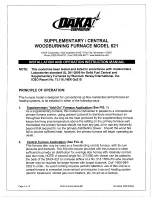
JINECI08 RevC 21/05/14
R
IDDLING
G
RATE
Your Hunter stove is fitted with a locomotive type
grate. So that de-ashing can be carried out cleanly
and easily, it is riddled from the outside of the stove
with the doors closed.
B
URNING
W
OOD
Pull the operating tool down and towards you. When
left in this position, air is restricted through the bed
of the fire providing a solid base to build up a bed of
ash.
It might prove beneficial when burning more reactive
fuels to leave the grate in a “neutral” position, thus
directing some under fire air and some over fire air to
the firebed.
L
IGHTING
We recommend that you have two or three small
fires before you operate your stove to its maximum
heat output. This is to allow the paint to cure in
steadily and to give a long service life to the paint
finish. During this curing in process you may notice
an unpleasant smell. It is non-toxic, but for your
comfort we would suggest that during this period
you leave all doors and windows open.
To light the fire, load the firebox with starting fuel,
i.e. paper, dry sticks and/or firelighters. Fully open
both air controls (by sliding fully to the right) and
light the fire at the base.
Wood burning
; Once the fire is established, close the
Primary Air Control (slide fully to the left) and add
more fuel as necessary. The secondary Air control can
now be used to regulate the burn rate of the stove.
When the stove is up to operating temperature the
operating tool or gloves should be used to operate
the air controls.
R
EFUELLING
With a 2.4kg load of wood, the stove will need to be
refuelled approximately once every 1.1 hours.
R
EDUCED
C
OMBUSTION
In order to shut down the stove, reduce the primary
and secondary air by sliding both controls to the left.
If the controls are left in this position, the fire will be
starved of air and will die down.
If you want to revive the fire it is recommended that
the primary air control is opened first, and then the
secondary air control.
Warning!-
The stove will remain
hot
for a
considerable time after the fire has been
extinguished.
T
HE
C
LEAN
A
IR
A
CT
1993
AND
S
MOKE
C
ONTROL
A
REAS
Under the Clean Air Act 1993 local authorities
may declare the whole or part of the district of
the authority to be a smoke control area. It is
an offence to emit smoke from a chimney of a
building, from a furnace or from any fixed
boiler if located in a designated smoke control
area. It is also an offence to acquire an
"unauthorised fuel" for use within a smoke
control area unless it is used in an "exempt"
appliance ("exempted" from the controls which
generally apply in the smoke control area).
The Secretary of State for Environment, Food
and Rural Affairs has powers under the Act to
authorise smokeless fuels or exempt
appliances for use in smoke control areas in
England. In Scotland and Wales this power
rests with Ministers in the devolved
administrations for those countries. Separate
legislation, the Clean Air (Northern Ireland)
Order 1981, applies in Northern Ireland.
Therefore it is a requirement that fuels burnt
or obtained for use in smoke control areas
have been "authorised" in Regulations and that
appliances used to burn solid fuel in those
areas (other than "authorised" fuels) have
been exempted by an Order made and signed
by the Secretary of State or Minister in the
devolved administrations.




































